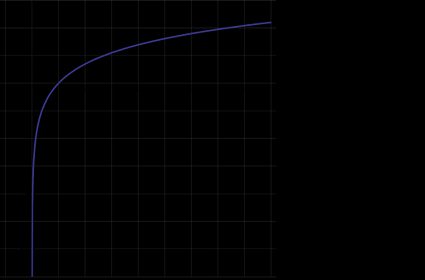How To Find Natural Log Of A Number
The natural log calculator determines the logarithm to the base of a famous mathematical abiding, e, an irrational number with an gauge value of e = 2.71828. Just, what is the natural logarithm, ln x, of a given number x? This is the power the number e has to be raised to in order to consequence in a given number ten.
How to use the natural logarithm calculator
Like all other logarithms, the natural logarithm of x returns the power, or exponent, to which a given base e must exist raised to yield back the number x. Information technology is easier to sympathise this notion when the base is an integer, for instance ii or iii:
log2 sixteen = 4 since ii4 = 16
logthree 81 = iv since 34 = 81.
In the instance of the natural logarithm, this is somewhat less intuitive, because it's base, e, is non an integer. But, since the value of e is between values of 2 and 3, we understand that e4 has to be somewhere betwixt 24 = 16 and 3iv = 81.
It turns out that e4 = 54.498. This equality can be stated in terms of the natural logarithm in the following way, which you lot can check past using the ln calculator:
ln 54.498 = iv.
Here are some examples of natural logarithm:
-
ln 1 = 0sincee0 = one -
ln 10 = 2.3026sinceeii.3026 = x -
ln twenty = ii.996sincee2.996 = 20 -
ln fifty = 3.912sincedue east3.912 = 50 -
ln 100 = four.605sincee4.605 = 100.
Check out the correctness of the above results by using our natural log figurer and the exponent calculator. In order to get a amend grasp of the coaction between the exponential and logarithm functions, y'all may want to check out our exponential and logarithm calculators.
Other ways to denote the natural logarithm
Ane way of cogent the natural logarithm is loge . This is the same as, say, when nosotros write the logarithm to the base two as log2.
But, a vastly more than common mode to write the natural logarithm is ln, which is an abbreviation of the Latin expression logarithmus naturalis, the name the natural logarithm was given when the Latin language was withal the lingua franca of scientific discipline.
There is as well a tertiary way of writing the natural logarithm: log. This note is somewhat problematic though, as information technology is often mistaken for the logarithm to the base x, although this is the syntax many software implementations of natural logarithm employ, so be careful!
What's then natural nearly the natural logarithm?
Why exactly does ln x deserve to exist called natural? Perhaps the well-nigh important holding of the natural logarithm is that it is the inverse office of the exponential function ex, the only function whose charge per unit of alter, or the derivative, is precisely again itself: (ex)' = due eastten .
In simpler words, the exponential part due east10 governs its own rate of modify, which in some sense makes it self-sufficient and non dependent on whatever other function to ascertain the way it changes. Exactly this property makes both ex and its inverse office ln x the natural option when describing many real-earth phenomena.
The natural log graph
Another interesting property of the natural logarithm is the way information technology changes its values every bit the argument ten increases. One way of expressing this is by stating that the derivative of the natural logarithm is inversely proportional to its value x, which tin can be written as (ln 10)' = 1/x.
Yous can also discover this belongings by looking at the graph of the natural logarithm. Although it increases as the value of ten increases, the rate of growth is getting smaller and smaller as 10 approaches higher and higher values:

Natural log graph
Source: Wikipedia Attribution: Elmextube (Public domain)
Where did the number e come up from
At start glance, you wouldn't say that the number e bears any importance to the endeavors of humans or nature. Simply this is not so! Information technology happens that this number is one of the well-nigh important constants in mathematics, so much so that information technology deserves a proper name. Information technology is called either Euler's number or Napier's constant, depending on whom of these two great mathematicians ane wants to aspect its discovery.
Nonetheless, it seems that Leonhard Euler (1707 - 1783) did go more than credit, based on the fact that the very alphabetic character Euler used to denote this constant is how we denoted it today. Although Euler was the first to calculate e to a significant number of decimal places, he wasn't the first one to discover it: read more than about it in the next paragraph.

Leonhard Euler
Source: Wikipedia Attribution: Jakob Emanuel Handmann (Public domain)
How to brand e amount of coin
Swiss mathematician Jacob Bernoulli (1654 - 1705) stumbled upon the existence of the number e when tackling the problem of chemical compound interest. Let united states of america first understand the idea behind unproblematic interest. For a given initial sum of money, allow's say ane USD, you want to know how much will you have after one year has passed if an interest of 100% is credited only once, and at the finish of the year? The reply is like shooting fish in a barrel: 2 USD.

Jacob Bernoulli
Source: Wikipedia Attribution: Niklaus Bernoulli (1662-1716) (Public domain)
But, with chemical compound interest, things get a bit more complicated. For example, if the same interest of 100% is now carve up into two equal parts of 50% and credited twice, fifty% at the cease of first vi months, and another 50% at the stop of the yr, and then the final yield is obtained by using the formula
one*(i + 1/2)2 = 2.25 USD.
Furthermore, if the interest of 100% is split in weekly lumps, you would have the final yield of
1*(1 + 1/52)52 = 2.692 USD.
Bernoulli asked a simple question: what would happen if compounding was continuous? In other words, what would be the final yield if the interest rate of 100% is split up into space parts, each credited at the cease of an infinitely short period of time? To meet in more item how continuous and other types of compounding work, you may want to cheque out our investment reckoner.
This problem of continuous compound interest, stated mathematically, boils down to the challenge of calculating the limit of (1 + 1/n)n as n approaches infinity. It turns out that the result is precisely the number e! Moreover, the to a higher place expression may be used as a way to define e. To answer the Bernoulli'due south question: with continuous compounding the initial dollar would yield precisely east = 2.718281828 USD at the stop of the twelvemonth!
The real-world importance of ln two and other natural logarithms
The easiest natural logarithms to calculate are:
ln 1 = 0 since east0 = 1, and
ln e = i since e1 = eastward.
Just, presumably the most important natural logarithm is the one that calculates the value of a number betwixt 1 and e, which turns out to be the number 2. Using the natural log calculator we get
ln 2 = 0.6931.
Information technology turns out that ln ii is also equal to the alternating sum of reciprocals of all natural numbers:
ln 2 = ane – ane/2 + 1/3 – 1/4 + 1/5 – 1/6 + ....
At outset glance, it appears that this number has no detail importance any. Only, ln 2, as obscure as it may seem, appears in some pretty meaning and at first glance unrelated real-globe problems.
For case, information technology has its office in the formula for the one-half-life of radioactively decaying thing, or in the adding of fourth dimension needed to double the initial amount of money, if a fixed rate is applied over a given time.
So, if yous have one,000 USD in your bank account, and the bank provides an r = seven% per annum interest rate, you may want to enquire yourself how long information technology will take to double my initial amount? Well, this is where ln 2 comes into play: the natural logarithm formula that calculates the time needed is (100 * ln two)/r, which can be simplified to the estimate value of 70/r. Besides 70, the number 72 is used fifty-fifty more often for this purpose, because it has more divisors: check out the rule of 72 estimator!
Therefore, in the case of r = seven%, you lot would get 70/7 = 10 years equally an estimate time needed for your initial sum of money to double. Similarly, one tin can get analogous formulas for the time needed for the initial quantity to triple, quadruple, or n-tuple, given a stock-still rate of growth over time.
Other applications of the natural logarithm
From the previous paragraph, we may conclude that natural logarithms occur in every process with a menstruation-related, abiding growth or decay of some quantifiable phenomenon.
Autonomously from already mentioned examples of radioactive decay and the problem of yield with a stock-still interest rate, natural logarithms announced when computing the bacterial, animal and plant population growth and disuse, decay rates of a charged capacitor, or the temperature change of an object.
References
- David Due south. Kahn: Attacking Problems in Logarithms and Exponential Functions, Dover Book on Mathematics, 2015
- Edward Kasner: Mathematics and the Imagination, Dover Books on Mathematics, 2001
How To Find Natural Log Of A Number,
Source: https://www.omnicalculator.com/math/natural-log
Posted by: reedyhadis1955.blogspot.com


0 Response to "How To Find Natural Log Of A Number"
Post a Comment